Study on the Deformation Control and Microstructures of Thin-Walled Parts Repaired by Laser Cladding
Abstract
1. Introduction
2. Materials and Methods
2.1. Experimental Equipment and Materials
2.2. Experimental Method
3. Results and Analysis
3.1. Visual Analysis
3.2. Analysis of Variance
3.3. Stress and Deformation Analysis of Laser-Clad Thin-Walled Parts
3.4. Microstructural Analysis
3.5. EDS and XRD Analysis
3.6. Microhardness Analysis
4. Conclusions
- According to the analysis of the orthogonal experiment results, the order of the influence of factors on the deformation of thin-walled parts from greatest to least was determined to be as follows: laser power > scanning speed > powder feed rate. The optimal parameters by which to obtain the minimum deformation and good metallurgical bonding of thin-walled parts were found to be a powder feed rate of 1.4 r/min, a laser power of 1,100 W, and a scanning speed of 8 mm/s.
- The amount of deformation in the thickness direction of the thin-walled parts was found to increase with the increase of the laser power. Increasing the scanning speed and the powder feed rate was found to reduce the amount of deformation in the thickness direction of the thin-walled parts. The laser power was found to have a significant effect on the deformation of thin-walled parts, but the powder feed rate was found to have no significant effect.
- Under the optimal process parameters, a good metallurgical bond was formed between the coating and the substrate, and the internal structure of the cladding layer was continuously dense without obvious defects, such as cracks and pores. This finding provides an important theoretical basis for the deformation control of thin-walled parts repaired by laser cladding.
Author Contributions
Funding
Acknowledgments
Conflicts of Interest
References
- Matsumoto, M.; Yang, S.; Martinsen, K.; Kainuma, Y. Trends and research challenges in remanufacturing. Int. J. Precis. Eng. Manuf. Green Technol. 2016, 3, 129–142. [Google Scholar] [CrossRef]
- Penaranda, X.; Moralejo, S.; Lamikiz, A.; Figueras, J. An adaptive laser cladding methodology for blade tip repair. Int. J. Adv. Manuf. Technol. 2017, 92, 4337–4343. [Google Scholar] [CrossRef]
- Um, J.; Rauch, M.; Hascoët, J.Y.; Stroud, I. Step-nc Compliant process planning of additive manufacturing: remanufacturing. Int. J. Adv. Manuf. Technol. 2017, 88, 1215–1230. [Google Scholar] [CrossRef]
- Xu, L.; Cao, H.; Liu, H.; Zhang, Y. Study on laser cladding remanufacturing process with FeCrNiCu alloy powder for thin-wall impeller blade. Int. J. Adv. Manuf. Technol. 2017, 90, 1383–1392. [Google Scholar]
- Wu, J.; Zhu, G.; Lu, B.; Shi, T.; Fu, G. Influence of self-regulation-effect on forming quality of thin-walled parts with variable laser spot cladding. J. Xi’an Jiaotong Univ. 2016, 50, 145–150. [Google Scholar]
- Sun, J.; Zhao, Y.; Yang, L.; Yu, T. Process optimization for improving topography quality and manufacturing accuracy of thin-walled cylinder direct laser fabrication. Int. J. Adv. Manuf. Technol. 2019, 105, 2087–2101. [Google Scholar] [CrossRef]
- Aghili, S.E.; Shamanian, M. Investigation of powder fed laser cladding of NiCr-chromium carbides single-tracks on titanium aluminide substrate. Opt. Laser Technol. 2019, 119, 105652. [Google Scholar] [CrossRef]
- Christian, K.; Holger, P.; Martin, R.; Frank, B.; Jens, B.; Christoph, L. Analysis of Melt Pool Characteristics and Process Parameters Using a Coaxial Monitoring System during Directed Energy Deposition in Additive Manufacturing. Materials 2019, 12, 308. [Google Scholar]
- Wang, X.; Sun, W.; Chen, Y.; Zhang, J.; Huang, Y.; Huang, H. Research on trajectory planning of complex curved surface parts by laser cladding remanufacturing. Int. J. Adv. Manuf. Technol. 2018, 96, 2397–2406. [Google Scholar] [CrossRef]
- Wang, J.; Han, F.; Ying, W. Surface evenness control of laser solid formed thin-walled parts based on the mathematical model of the single cladding layer thickness. J. Laser Appl. 2019, 31, 022009. [Google Scholar] [CrossRef]
- Yu, T.; Sun, J.; Qu, W.; Zhao, Y.; Yang, L. Influences of z-axis increment and analyses of defects of AISI 316L stainless steel hollow thin-walled cylinder. Int. J. Adv. Manuf. Technol. 2018, 97, 2203–2220. [Google Scholar] [CrossRef]
- Niz’ev, V.G.; Khomenko, M.D.; Mirzade, F.K. Process planning and optimisation of laser cladding considering hydrodynamics and heat dissipation geometry of parts. Quantum Electron. 2018, 48, 743–748. [Google Scholar] [CrossRef]
- Zhao, J.; Xie, D.; Liang, H.; Xiao, M.; Shen, L.; Tian, Z. Review of distortion and residual stress in metal additive manufacturing. J. Nanjing Univ. Aeronaut. Astronaut. 2019, 51, 1–6. [Google Scholar]
- Ning, J.; Sievers, D.E.; Garmestani, H.; Liang, S.Y. Analytical modeling of in-situ deformation of part and substrate in laser cladding additive manufacturing of Inconel 625. J. Manuf. Process. 2020, 49, 135–140. [Google Scholar] [CrossRef]
- Meng, L.; Zeng, X.; Hou, K.; Hu, Q.; Wang, D. Effect of laser cladding and laser-induction hybrid cladding coatings on the bending properties and fracture behavior of rails. Surf. Coat. Technol. 2019, 374, 1038–1050. [Google Scholar] [CrossRef]
- Jinoop, A.N.; Denny, J.; Paul, C.P.; Kumar, J.G.; Bindra, K.S. Effect of post heat-treatment on the microstructure and mechanical properties of hastelloy-x structures manufactured by laser based directed energy deposition. J. Alloy. Compd. 2019, 797, 399–412. [Google Scholar] [CrossRef]
- Ding, C.; Cui, X.; Jiao, J.; Zhu, P. Effects of substrate preheating temperatures on the microstructure, properties, and residual stress of 12crni2 prepared by laser cladding deposition technique. Materials 2018, 11, 2401. [Google Scholar] [CrossRef]
- Li, R.; Qiu, Y.; Zheng, Q.; Liu, B.; Chen, S.; Tian, Y. Finite element simulation of temperature and stress field for laser cladded nickel-based amorphous composite coatings. Coatings 2018, 8, 336. [Google Scholar] [CrossRef]
- Tao, Y.; Li, J.; Lu, Y.; Hu, L. Residual stress distribution in different depths of TiNi/Ti2Ni-based laser clad coating prepared at different environmental temperatures. Trans. Nonferr Metal. Soc. China 2017, 27, 2043–2054. [Google Scholar] [CrossRef]
- Wang, D.; Hu, Q.; Zeng, X. Residual stress and cracking behaviors of Cr13Ni5Si2-based compositecoatings prepared by laser-induction hybrid cladding. Surf. Coat. Technol. 2015, 274, 51–59. [Google Scholar] [CrossRef]
- Narayanan, A.; Mostafavi, M.; Pirling, T.; Kabra, S.; Lewis, R.; Pavier, M.J.; Peel, M.J. Residual stress in laser cladded rail. Tribol. Int. 2019, 140, 105844. [Google Scholar] [CrossRef]
- Yu, J.; Sun, W.; Huang, H.; Wang, W.; Wang, Y.; Hu, Y. Crack sensitivity control of nickel-based laser coating based on genetic algorithm and neural network. Coatings 2019, 9, 728. [Google Scholar] [CrossRef]
- Wang, X.; Deng, D.; Yi, H.; Xu, H.; Yang, S.; Zhang, H. Influences of pulse laser parameters on properties of AISI316L stainless steel thin-walled part by laser material deposition. Opt. Laser Technol. 2017, 92, 5–14. [Google Scholar] [CrossRef]
- Krzyzanowski, M.; Bajda, S.; Liu, Y. 3D analysis of thermal and stress evolution during laser cladding of bioactive glass coatings. J. Mech. Behav. Biomed. 2016, 59, 404–417. [Google Scholar] [CrossRef] [PubMed]
- Yan, H.; Shen, L.; Wang, X.; Tian, Z.; Xu, G.; Xie, D.; Liang, H. Stress and deformation evaluation of the subarea scanningeffect in direct laser-deposited Ti-6Al-4V. Int. J. Adv. Manuf. Technol. 2018, 97, 915–926. [Google Scholar] [CrossRef]
- Yan, Z.; Liu, W.; Tang, Z.; Liu, X.; Zhang, N.; Wang, Z.; Zhang, H. Effect of thermal characteristics on distortion in laser cladding of aisi 316l. J. Manuf. Process. 2019, 44, 309–318. [Google Scholar] [CrossRef]
- Huang, K.; Xie, C.; Xu, D. Deformation measurement of thin plate die steel during pulsed nd: YAG laser remelting. Chin. J. Lasers 2003, 30, 750–754. [Google Scholar]
- Wang, K.; Du, D.; Liu, G.; Chang, B.; Ju, J.; Sun, S.; Fu, H. Microstructure and property of laser clad Fe-based composite layer containing Nb and B4C powders. J. Alloy. Compd. 2019, 802, 373–384. [Google Scholar] [CrossRef]
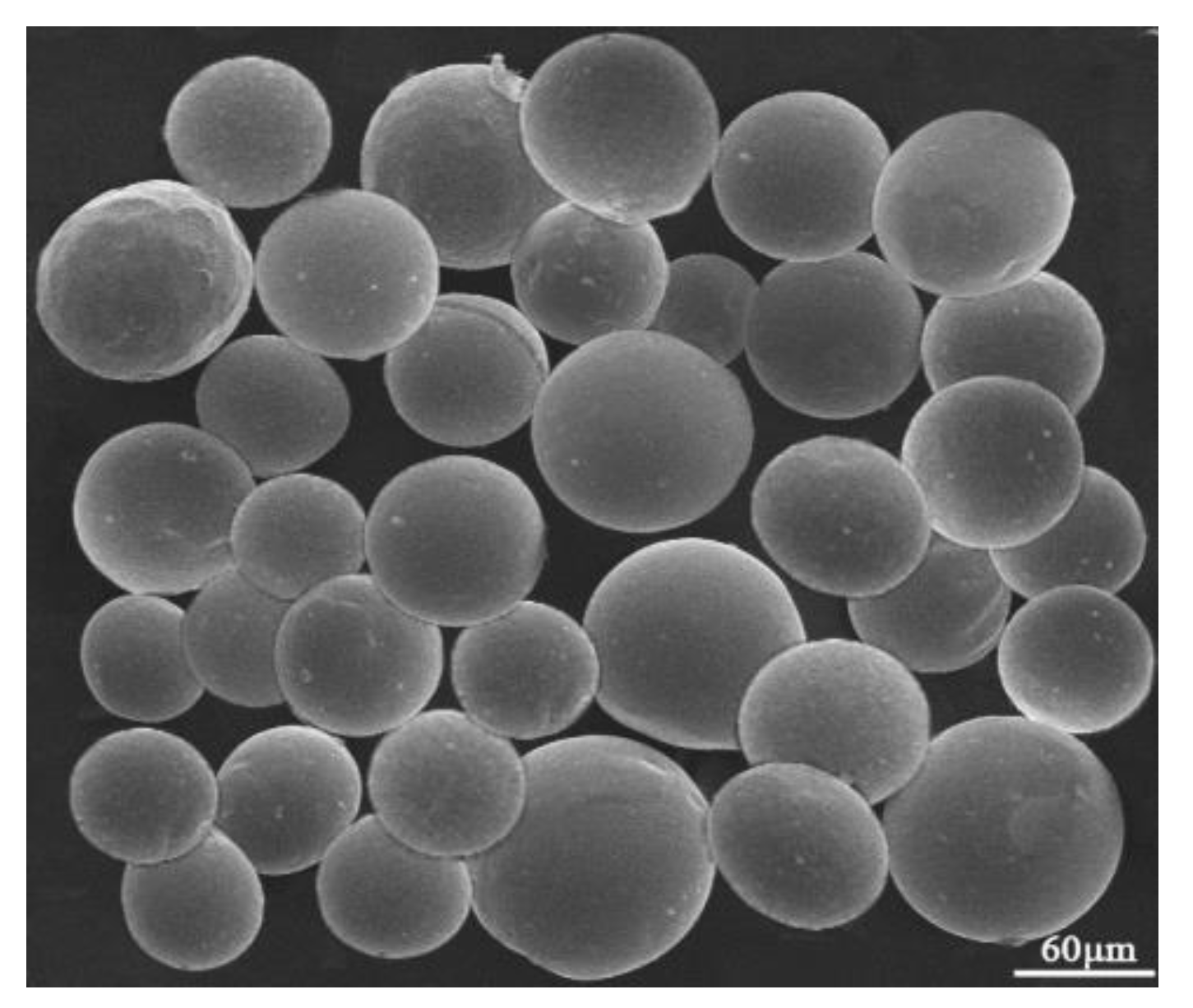
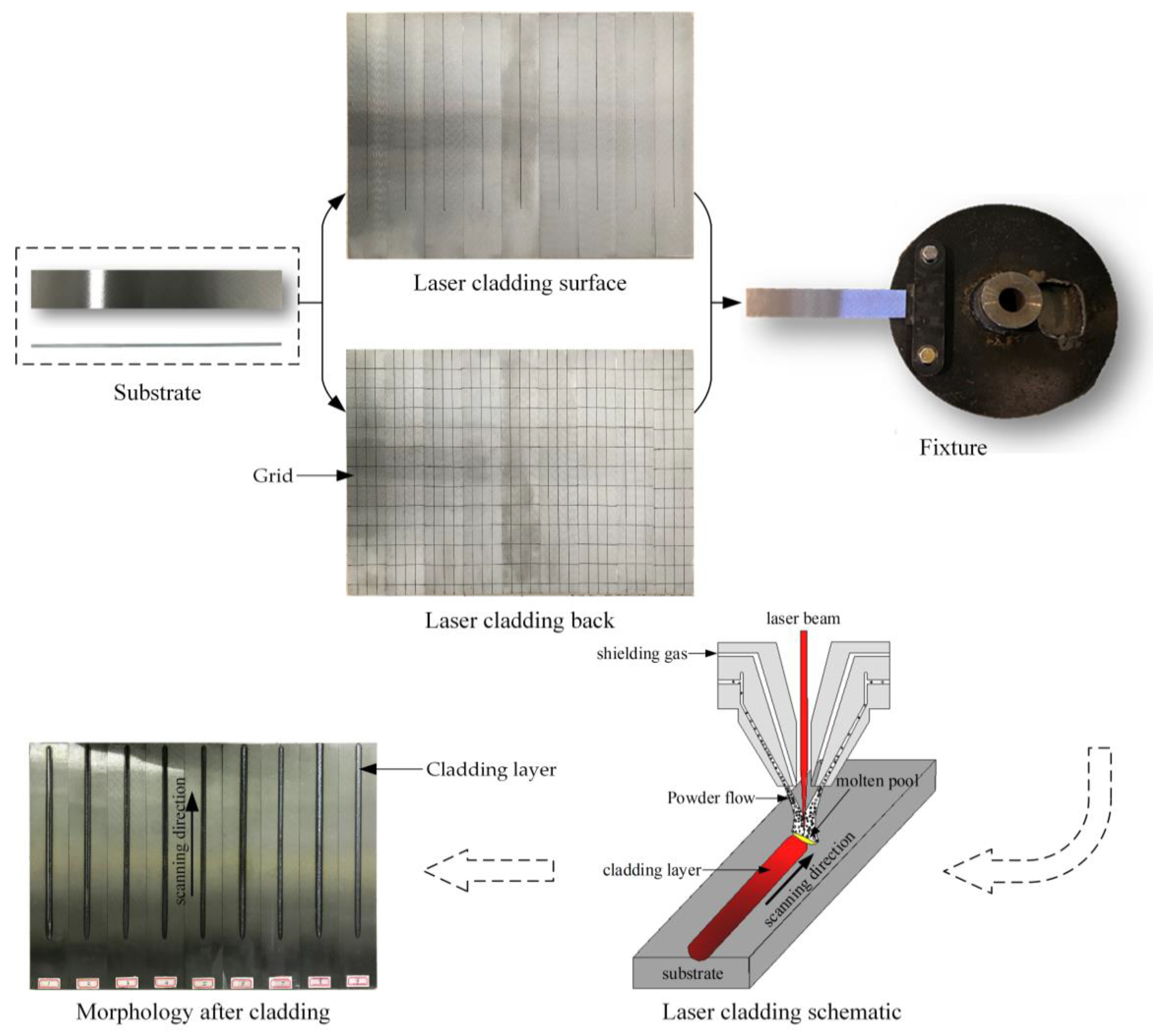

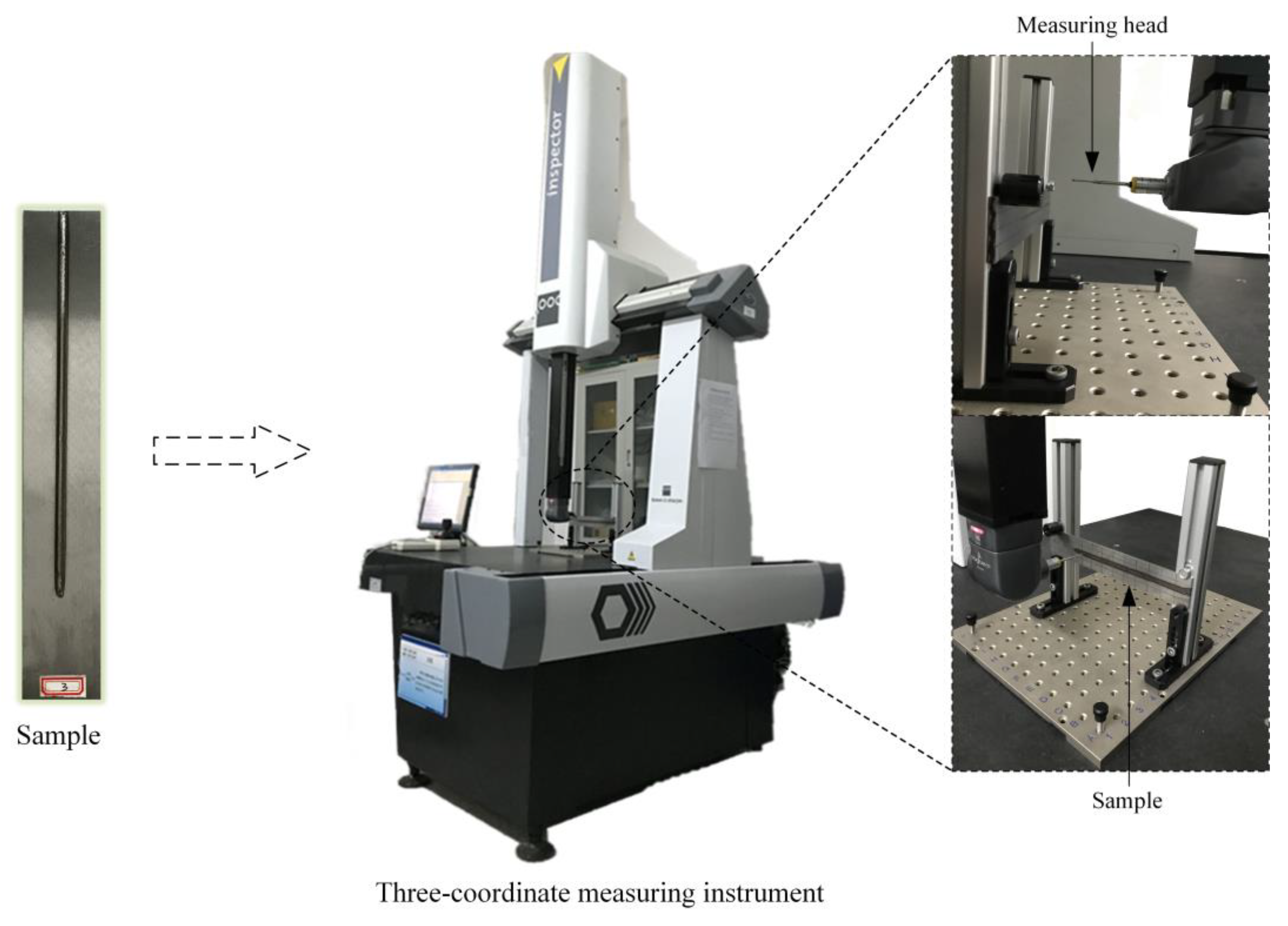

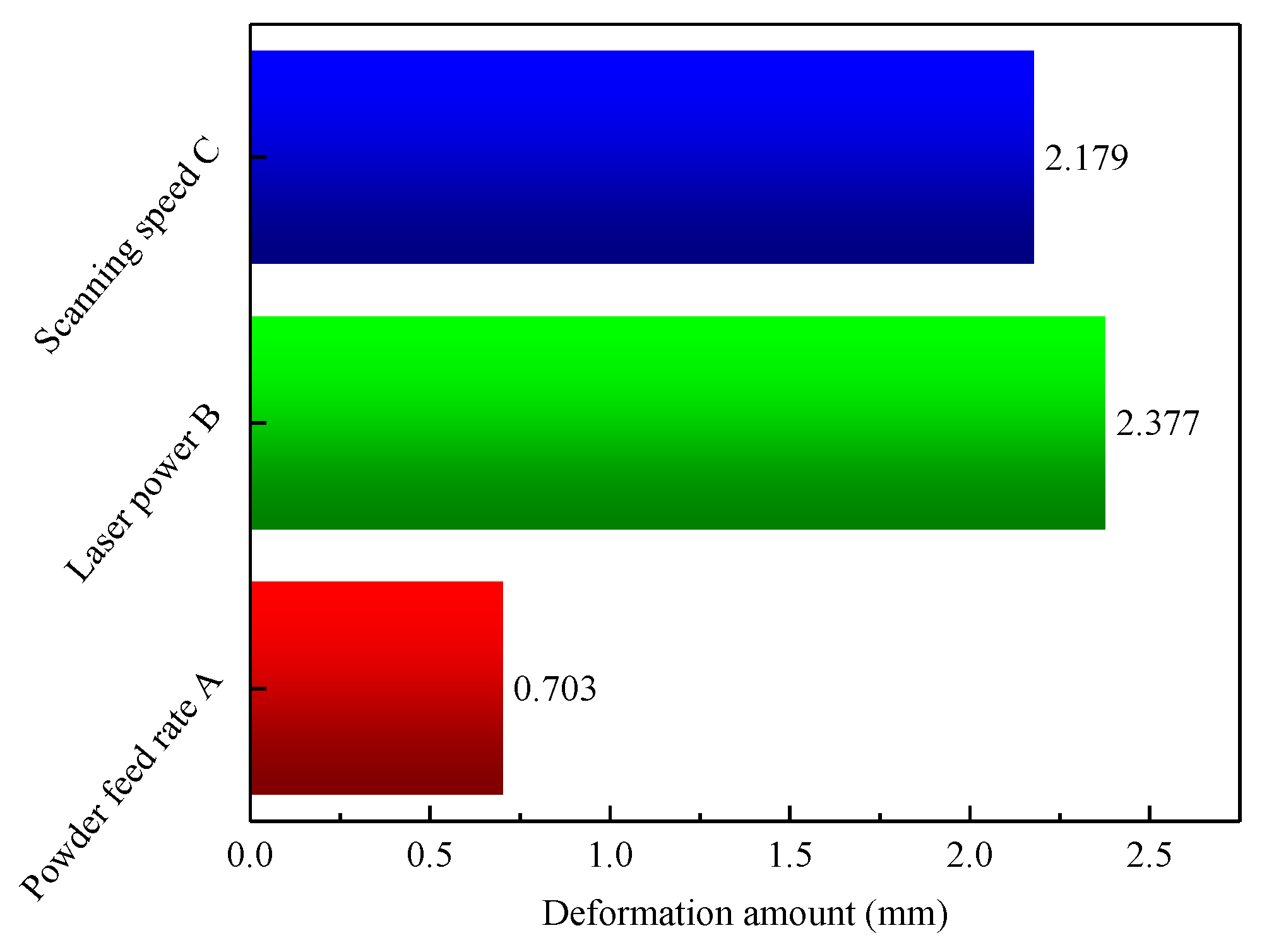
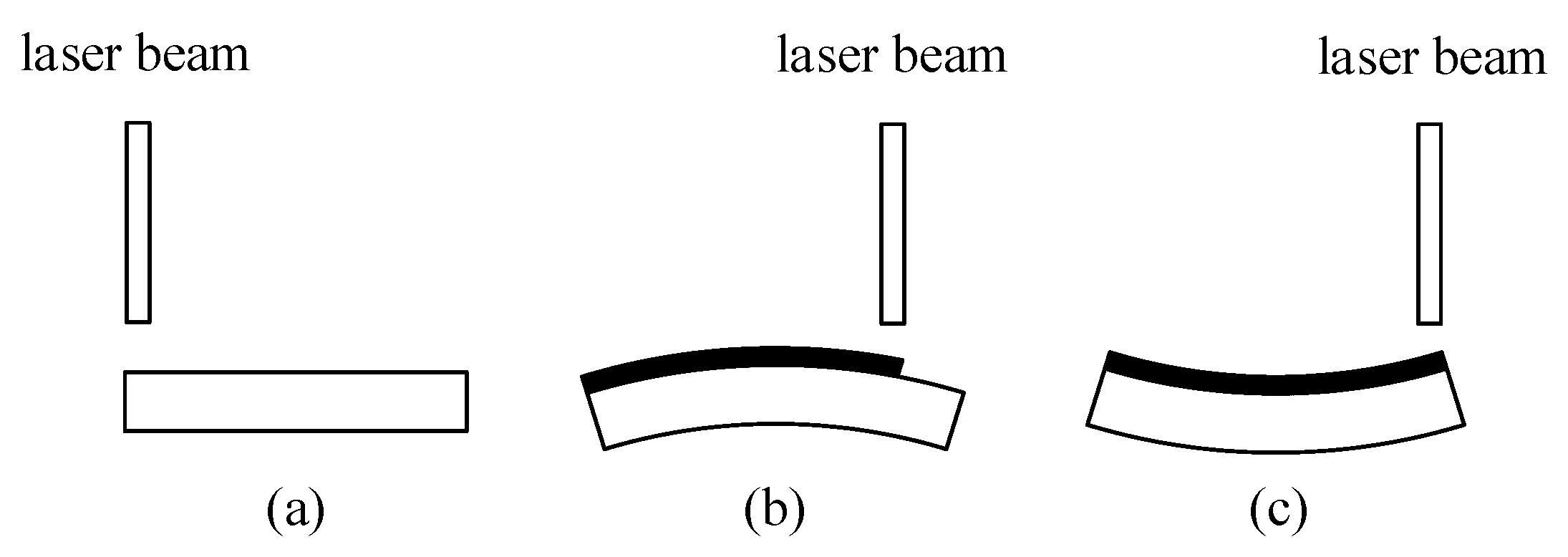
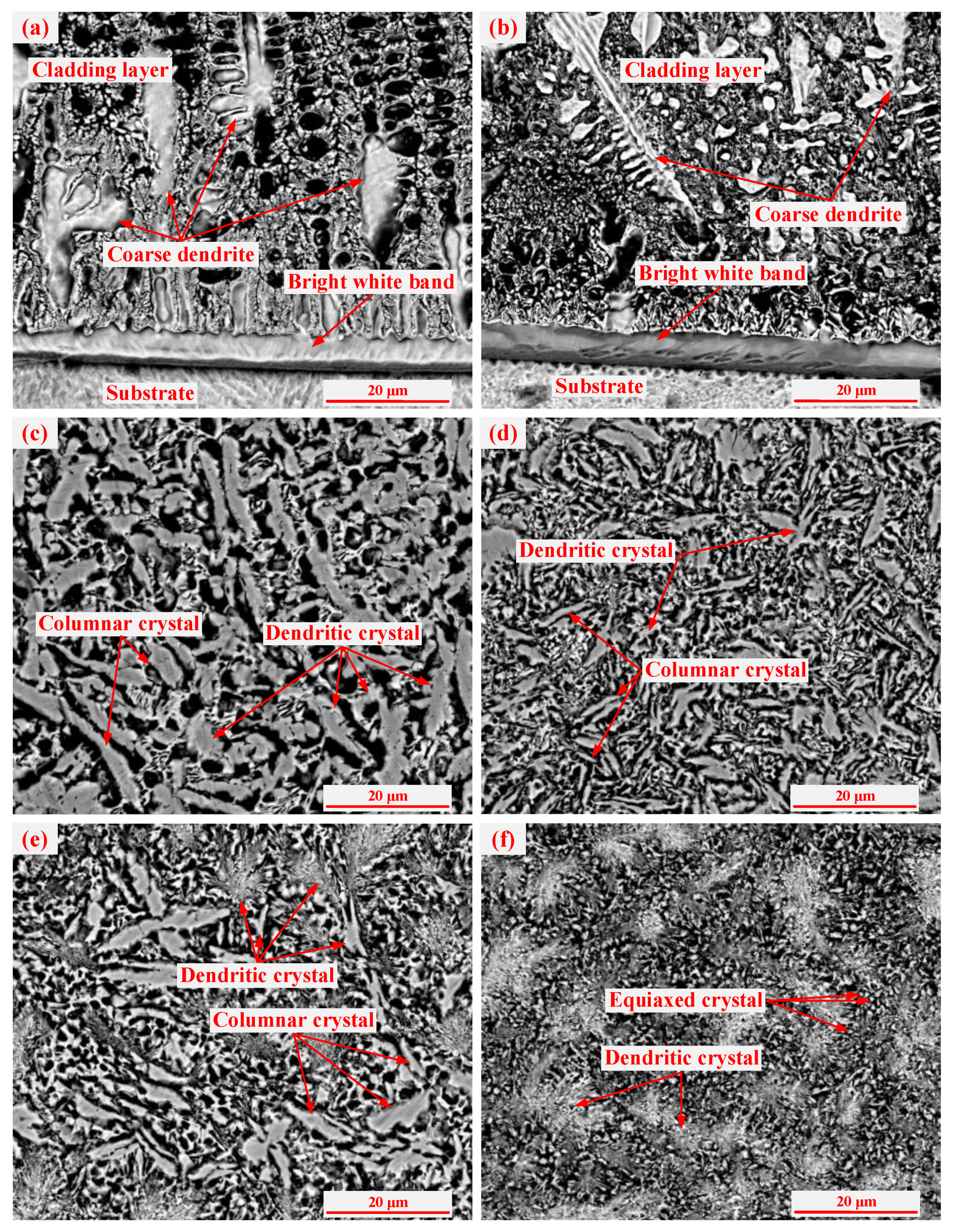
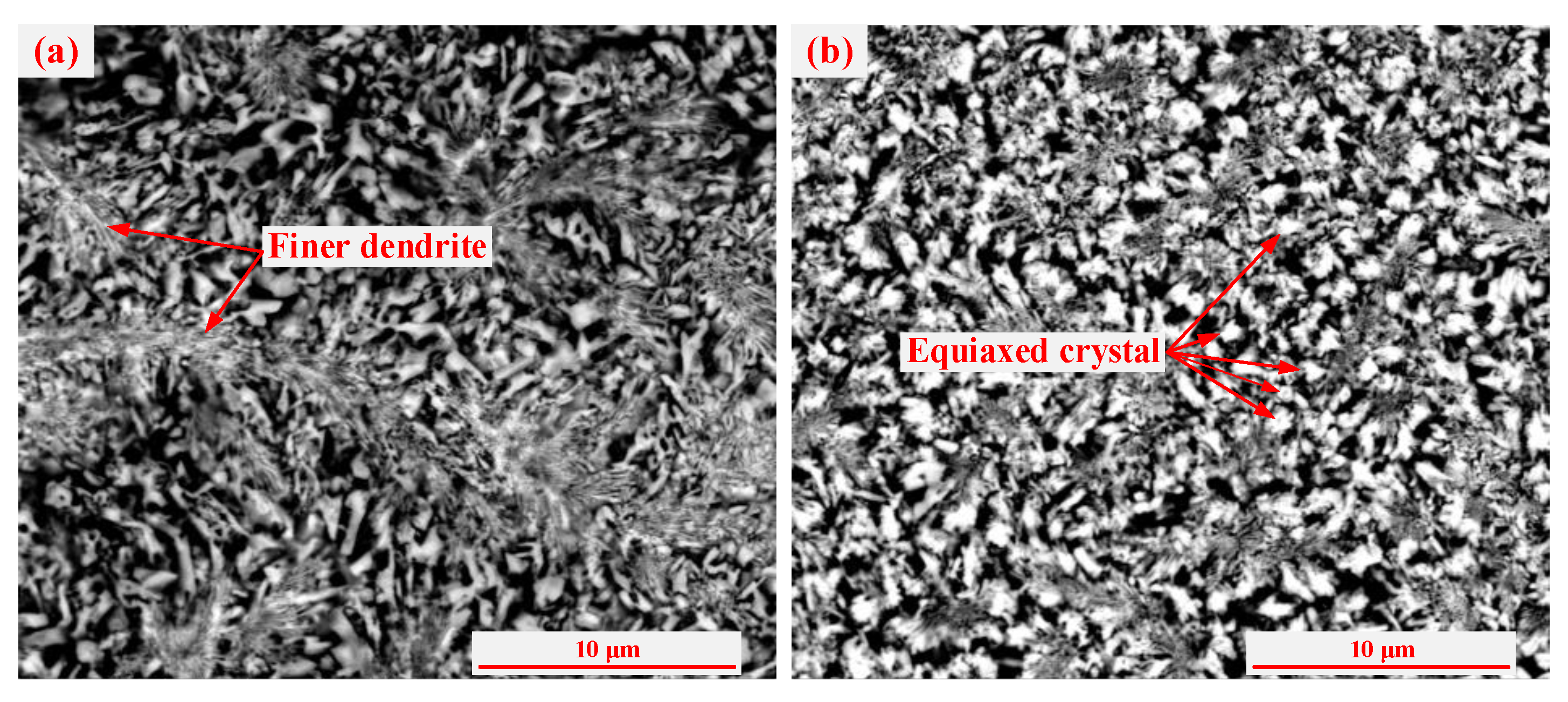
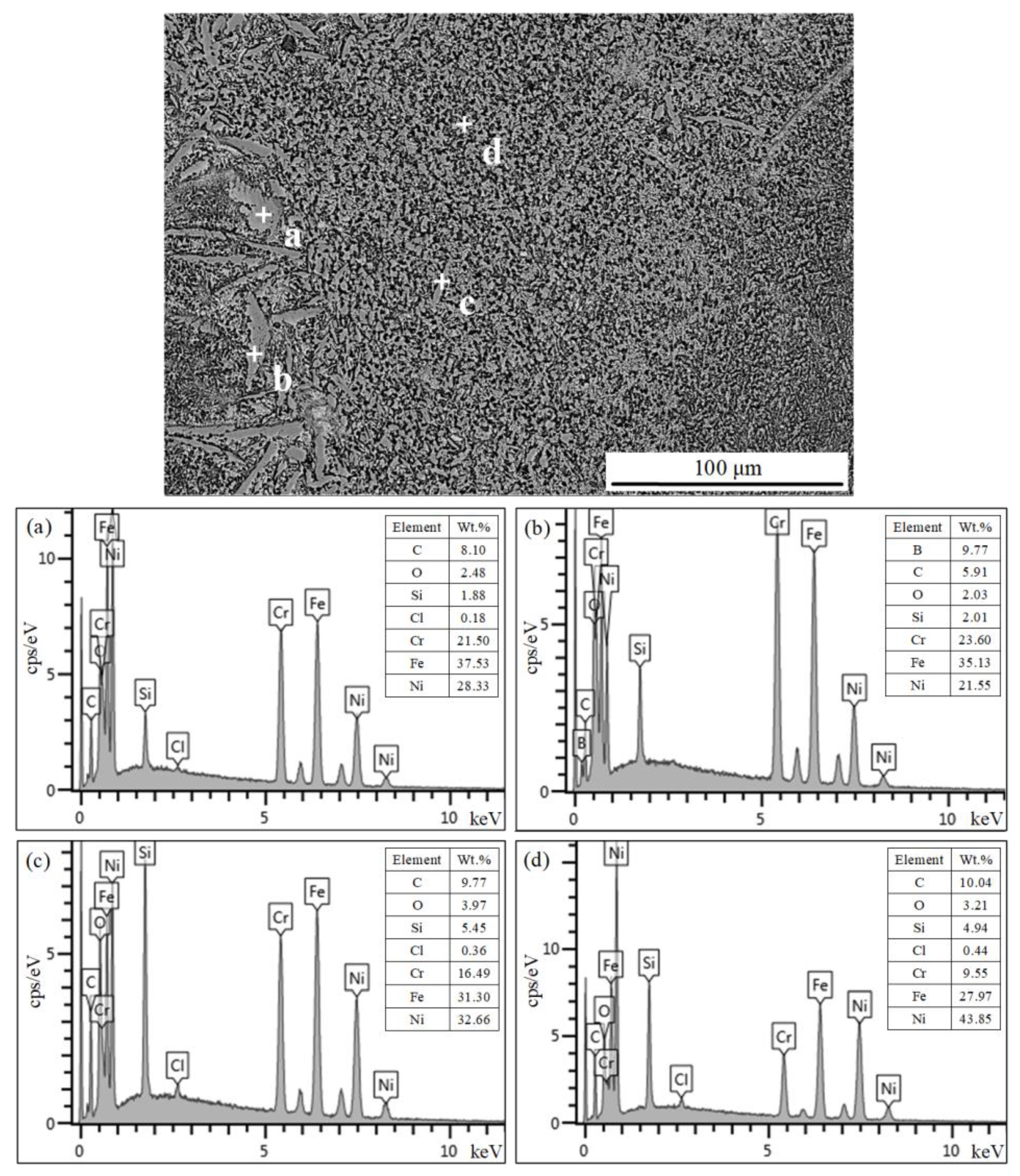


| Element | Cr | S | Si | C | p | Mn | Ni | Cu |
|---|---|---|---|---|---|---|---|---|
| Content | ≤0.25 | ≤0.035 | 0.17~0.37 | 0.42~0.50 | ≤0.035 | 0.50~0.80 | ≤0.25 | ≤0.25 |
| Element | C | Cr | B | Si | Fe | Ni |
|---|---|---|---|---|---|---|
| Content | 0.8 | 16 | 3.5 | 4.5 | ≤15.0 | Bal. |
| Level | Factor | ||
|---|---|---|---|
| Powder Feed Rate A/(r/min) | Laser Power B/(W) | Scanning Speed C/(mm/s) | |
| 1 | 1 | 1100 | 4 |
| 2 | 1.2 | 1300 | 6 |
| 3 | 1.4 | 1500 | 8 |
| Samples | A/(r/min) | B/(W) | C/(mm/s) | Blank Column |
|---|---|---|---|---|
| 1 | 1 | 1 | 1 | 1 |
| 2 | 1 | 2 | 2 | 2 |
| 3 | 1 | 3 | 3 | 3 |
| 4 | 2 | 1 | 2 | 3 |
| 5 | 2 | 2 | 3 | 1 |
| 6 | 2 | 3 | 1 | 2 |
| 7 | 3 | 1 | 3 | 2 |
| 8 | 3 | 2 | 1 | 3 |
| 9 | 3 | 3 | 2 | 1 |
| Measuring Points | Samples | ||||||||
|---|---|---|---|---|---|---|---|---|---|
| 1 | 2 | 3 | 4 | 5 | 6 | 7 | 8 | 9 | |
| 1 | 3.573 | 4.268 | 3.755 | 2.235 | 2.220 | 6.189 | 0.700 | 4.456 | 4.118 |
| 2 | 3.365 | 4.019 | 3.653 | 2.005 | 1.994 | 6.138 | 0.690 | 4.221 | 4.081 |
| 3 | 3.315 | 3.945 | 3.584 | 1.952 | 1.831 | 6.067 | 0.685 | 4.075 | 3.944 |
| 4 | 3.219 | 3.827 | 3.574 | 1.856 | 1.807 | 6.052 | 0.670 | 4.019 | 3.921 |
| 5 | 3.219 | 3.740 | 3.565 | 1.783 | 1.769 | 5.980 | 0.669 | 3.954 | 3.778 |
| 6 | 3.098 | 3.694 | 3.486 | 1.777 | 1.747 | 5.093 | 0.651 | 3.823 | 3.710 |
| 7 | 3.029 | 3.470 | 3.431 | 1.767 | 1.642 | 5.000 | 0.631 | 3.588 | 3.687 |
| 8 | 2.982 | 3.446 | 3.404 | 1.765 | 1.615 | 4.954 | 0.600 | 3.418 | 3.575 |
| 9 | 2.885 | 3.247 | 3.388 | 1.693 | 1.614 | 4.781 | 0.599 | 3.384 | 3.532 |
| 10 | 2.879 | 3.148 | 3.331 | 1.636 | 1.550 | 4.737 | 0.594 | 3.329 | 3.335 |
| Averages | 3.156 | 3.681 | 3.517 | 1.847 | 1.779 | 5.499 | 0.649 | 3.827 | 3.768 |
| Experimental Index | Factor | |||
|---|---|---|---|---|
| Powder Feed Rate A | Laser Power B | Scanning Speed C | Blank Column | |
| K1 | 10.353 | 5.652 | 12.48 | 8.704 |
| K2 | 9.126 | 9.288 | 9.297 | 9.828 |
| K3 | 8.244 | 12.783 | 5.946 | 9.191 |
| k1 | 3.451 | 1.884 | 4.160 | 2.901 |
| k2 | 3.042 | 3.096 | 3.099 | 3.276 |
| k3 | 2.748 | 4.261 | 1.982 | 3.064 |
| Range (Rj) | 0.703 | 2.377 | 2.179 | 0.375 |
| Influence order | B > C > A | |||
| Optimal level | A3 | B1 | C3 | |
| Optimal group | A3B1C3 | |||
| Source of Variance | Sum of Squares SS | Degrees of Freedom df | Mean Square MS | F Value | Critical Value Fα | Saliency | Reliability |
|---|---|---|---|---|---|---|---|
| A | 0.748 | 2 | 0.374 | 3.528 | |||
| B | 8.476 | 2 | 4.238 | 39.981 | F0.025 (2, 2) = 39 | ** | 97.5% |
| C | 7.117 | 2 | 3.559 | 33.575 | F0.05 (2, 2) = 19 | * | 95% |
| Error e | 0.212 | 2 | 0.106 | ||||
| Sum T | 16.558 | 8 |
© 2020 by the authors. Licensee MDPI, Basel, Switzerland. This article is an open access article distributed under the terms and conditions of the Creative Commons Attribution (CC BY) license (http://creativecommons.org/licenses/by/4.0/).
Share and Cite
Yu, J.; Sun, W.; Huang, H.; Huang, Y. Study on the Deformation Control and Microstructures of Thin-Walled Parts Repaired by Laser Cladding. Coatings 2020, 10, 369. https://doi.org/10.3390/coatings10040369
Yu J, Sun W, Huang H, Huang Y. Study on the Deformation Control and Microstructures of Thin-Walled Parts Repaired by Laser Cladding. Coatings. 2020; 10(4):369. https://doi.org/10.3390/coatings10040369
Chicago/Turabian StyleYu, Jiangtong, Wenlei Sun, Haibo Huang, and Yong Huang. 2020. "Study on the Deformation Control and Microstructures of Thin-Walled Parts Repaired by Laser Cladding" Coatings 10, no. 4: 369. https://doi.org/10.3390/coatings10040369
APA StyleYu, J., Sun, W., Huang, H., & Huang, Y. (2020). Study on the Deformation Control and Microstructures of Thin-Walled Parts Repaired by Laser Cladding. Coatings, 10(4), 369. https://doi.org/10.3390/coatings10040369




